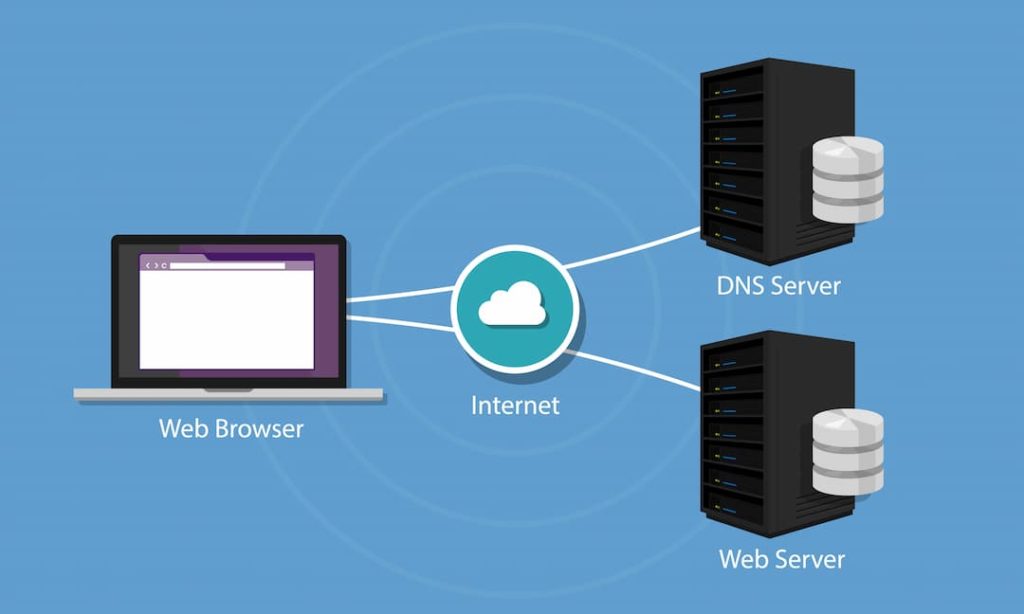Your domain name is a unique, easily remembered address that is typed into a web browser to access your website. For example, to visit our site directly, you need to type search4local.co.uk into your browser.
This address means users can access websites with a little help from the DNS, which stands for Domain Name System.
The DNS is required because the domain name not the true address of a website. A real web address is made up of a complex string of numbers, which form what’s called an IP address. This might look something like 192.168.1.254.
DNS allows us to use human-friendly and memorable domain names to direct users to IP addresses. Confused? Let’s explain it further.
What Is An IP Address?
IP stands for Internet Protocol. It’s an identifier made up of a string of numbers that can point to a device or network. It helps devices and website connect with each other online.

When you type a web address into the search bar, your computer needs to know where that website is and how to reach it. That’s what the IP address’s job is.
What Is A URL?
URL stands for Uniform Resource Locator. A URL is another way of talking about your website address. Generally, when talking about a URL you include things like https:// and www. – if you have that. Not every website needs a www. A URL may also include a slug, also known as a page path, which is the path to a specific page on a site. For example, if you wanted to go to the Search4Local blog, you’d use the url search4local.co.uk/blog/. In that URL, /blog/ is the page path.

The image above is a URL. It comprises of many different parts that all play an important role in using the internet.
Protocol
The protocol section of the domain tells the browser how to connect to the server. You’ll probably recognise the most common protocols, which are http and https. These stand for hypertext transfer protocol, and hypertext transfer protocol secure. As the name suggests, https is more secure as the request is encrypted.
Sub Domain
The sub domain is an extension of your domain that’s used to organise separate parts of your website. For example, www.search4local.co.uk will take you to the Search4Local website. However, mail.search4local.co.uk could take you to the email services for Search4Local.
TLD
TLD stands for Top Level Domain. The TLD is one of the most important parts of the domain name system and comes in many different varieties. Some generic TLDs include .com, .info, .net and .org.

Some TLDs are known as Sponsored TLDs. These require a sponsor that represents the community that the domain serves. For example, .gov and .edu are reserved for government and educational associations only.
Finally, we have country code TLDs, which include .uk, .wales and .us. These help users to identify which country a website operates in.
There are plenty of other premium TLDs which usually come with a hefty annual cost, such as .venture, .ninja and even .beer!
Page Path
The page path, sometimes referred to as the slug, simply directs the user to a specific page within the domain name’s website.
How Does The Domain Name System Work?
DNS stands for Domain Name System. DNS translates URLs to IP addresses, so users can easily browse and locate websites without having to remember complex numerical data.
The DNS System works much like a phone book. It manages and maps domain names to the IP Address’ of their servers. The process for this contains many very important steps. We’ve broken the process down into 10 steps, using our website as an example.

- A User types www.search4local.co.uk into their browser
- The query is received by a DNS Resolver
- This DNS Resolver further queries the Root Nameserver
- The Root Server sends the address of the TLD back to the resolver (.co.uk)
- The DNS resolver queries the .co.uk TLD Nameserver
- The TLD Nameserver responds with the IP address of the authoritative nameserver
- The DNS Resolver queries the domains Authoritative nameserver
- The Authoritative nameserver returns the IP address of the desired domain
- The DNS Resolver enters the IP address into the browser
- The user accesses the webpage
While this may seem like a very long-winded process, the time it takes to complete is roughly the same as the time it takes you to blink. The DNS System was developed to be exceptionally fast.
Can I Change My Domain Name?
Yes! However, it’s not advisable.
This may depend on your situation. Your domain name should be something that’s easy to remember which you are going to keep for the foreseeable future. This is why it’s a great idea for your domain name to be the same as your business name.
If you rank well on search engines, the trust that they have for your website is tied with your domain name. If you choose to change it, you will have to ensure you do everything you possibly can to let them know that your website is still the same.
This is not a simple process. Before migrating domains, we recommend you check out one of the many domain migration checklists online to ensure you are in the best possible position to change your domain name and not lose your current ranking in search engines. Otherwise, you may have to start this from scratch with an extensive SEO strategy. An SEO strategy on a new website can take a long time to work, so it’s really important to consider the implications that changing your domain name might have.
Written by Alice Farley




